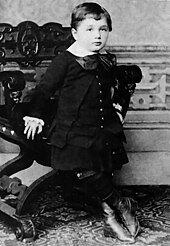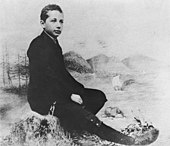Albert Einstein (/ˈaɪnstaɪn/ EYEN-styne; German: [ˈalbɛɐ̯t ˈʔaɪnʃtaɪn] (
Near the beginning of his career, Einstein thought that Newtonian mechanics was no longer enough to reconcile the laws of classical mechanics with the laws of the electromagnetic field. This led him to develop his special theory of relativity during his time at the Swiss Patent Office in Bern (1902–1909). However, he realized that the principle of relativity could also be extended to gravitational fields, and he published a paper on general relativity in 1916 with his theory of gravitation. He continued to deal with problems of statistical mechanics and quantum theory, which led to his explanations of particle theory and the motion of molecules. He also investigated the thermal properties of light which laid the foundation of the photon theory of light. In 1917, he applied the general theory of relativity to model the structure of the universe.
Except for one year in Prague, Einstein lived in Switzerland between 1895 and 1914, during which time he renounced his German citizenship in 1896, then received his academic diploma from the Swiss federal polytechnic school (later the Eidgenössische Technische Hochschule, ETH) in Zürich in 1900. After being stateless for more than five years, he acquired Swiss citizenship in 1901, which he kept for the rest of his life. In 1905, he was awarded a PhD by the University of Zurich. The same year, he published four groundbreaking papers during his renowned annus mirabilis (miracle year) which brought him to the notice of the academic world at the age of 26. Einstein taught theoretical physics at Zurich between 1912 and 1914, before he left for Berlin, where he was elected to the Prussian Academy of Sciences.
In 1933, while Einstein was visiting the United States, Adolf Hitler came to power. Because of his Jewish background, Einstein did not return to Germany. He settled in the United States and became an American citizen in 1940. On the eve of World War II, he endorsed a letter to President Franklin D. Roosevelt alerting him to the potential development of "extremely powerful bombs of a new type" and recommending that the US begin similar research. This eventually led to the Manhattan Project. Einstein supported the Allies, but he generally denounced the idea of using nuclear fission as a weapon. He signed the Russell–Einstein Manifesto with British philosopher Bertrand Russell, which highlighted the danger of nuclear weapons. He was affiliated with the Institute for Advanced Study in Princeton, New Jersey, until his death in 1955.
Einstein published more than 300 scientific papers and more than 150 non-scientific works. His intellectual achievements and originality have made the word "Einstein" synonymous with "genius". Eugene Wigner wrote of Einstein in comparison to his contemporaries that "Einstein's understanding was deeper even than Jancsi von Neumann's. His mind was both more penetrating and more original than von Neumann's. And that is a very remarkable statement."



Albert Einstein was born in Ulm, in the Kingdom of Württemberg in the German Empire, on 14 March 1879. His parents were Hermann Einstein, a salesman and engineer, and Pauline Koch. In 1880, the family moved to Munich, where Einstein's father and his uncle Jakob founded Elektrotechnische Fabrik J. Einstein & Cie, a company that manufactured electrical equipment based on direct current.
The Einsteins were non-observant Ashkenazi Jews, and Albert attended a Catholic elementary school in Munich, from the age of 5, for three years. At the age of 8, he was transferred to the Luitpold Gymnasium (now known as the Albert Einstein Gymnasium), where he received advanced primary and secondary school education until he left the German Empire seven years later.
In 1894, Hermann and Jakob's company lost a bid to supply the city of Munich with electrical lighting because they lacked the capital to convert their equipment from the direct current (DC) standard to the more efficient alternating current (AC) standard. The loss forced the sale of the Munich factory. In search of business, the Einstein family moved to Italy, first to Milan and a few months later to Pavia. When the family moved to Pavia, Einstein, then 15, stayed in Munich to finish his studies at the Luitpold Gymnasium. His father intended for him to pursue electrical engineering, but Einstein clashed with authorities and resented the school's regimen and teaching method. He later wrote that the spirit of learning and creative thought was lost in strict rote learning. At the end of December 1894, he travelled to Italy to join his family in Pavia, convincing the school to let him go by using a doctor's note. During his time in Italy he wrote a short essay with the title "On the Investigation of the State of the Ether in a Magnetic Field".
Einstein always excelled at math and physics from a young age, reaching a mathematical level years ahead of his peers. The twelve-year-old Einstein taught himself algebra and Euclidean geometry over a single summer. Einstein also independently discovered his own original proof of the Pythagorean theorem at age 12. A family tutor Max Talmud says that after he had given the 12-year-old Einstein a geometry textbook, after a short time "[Einstein] had worked through the whole book. He thereupon devoted himself to higher mathematics... Soon the flight of his mathematical genius was so high I could not follow." His passion for geometry and algebra led the twelve-year-old to become convinced that nature could be understood as a "mathematical structure". Einstein started teaching himself calculus at 12, and as a 14-year-old he says he had "mastered integral and differential calculus".
At age 13, Einstein was introduced to Kant's Critique of Pure Reason, and Kant became his favorite philosopher, his tutor stating: "At the time he was still a child, only thirteen years old, yet Kant's works, incomprehensible to ordinary mortals, seemed to be clear to him."
In 1895, at the age of 16, Einstein took the entrance examinations for the Swiss Federal Polytechnic in Zürich (later the Eidgenössische Technische Hochschule, ETH). He failed to reach the required standard in the general part of the examination, but obtained exceptional grades in physics and mathematics. On the advice of the principal of the Polytechnic, he attended the Argovian cantonal school (gymnasium) in Aarau, Switzerland, in 1895 and 1896 to complete his secondary schooling. While lodging with the family of professor Jost Winteler, he fell in love with Winteler's daughter, Marie. Albert's sister Maja later married Winteler's son Paul. In January 1896, with his father's approval, Einstein renounced his citizenship in the German Kingdom of Württemberg to avoid military service. In September 1896, he passed the Swiss Matura with mostly good grades, including a top grade of 6 in physics and mathematical subjects, on a scale of 1–6. At 17, he enrolled in the four-year mathematics and physics teaching diploma program at the Zürich Polytechnic. Marie Winteler, who was a year older, moved to Olsberg, Switzerland, for a teaching post.
Einstein's future wife, a 20-year-old Serbian woman Mileva Marić, also enrolled at the Polytechnic that year. She was the only woman among the six students in the mathematics and physics section of the teaching diploma course. Over the next few years, Einstein's and Marić's friendship developed into romance, and they read books together on extra-curricular physics in which Einstein was taking an increasing interest. In 1900, Einstein passed the exams in Maths and Physics and was awarded the Federal Polytechnic teaching diploma. There have been claims that Marić collaborated with Einstein on his 1905 papers, known as the Annus Mirabilis papers, but historians of physics who have studied the issue find no evidence that she made any substantive contributions.






No comments:
Post a Comment